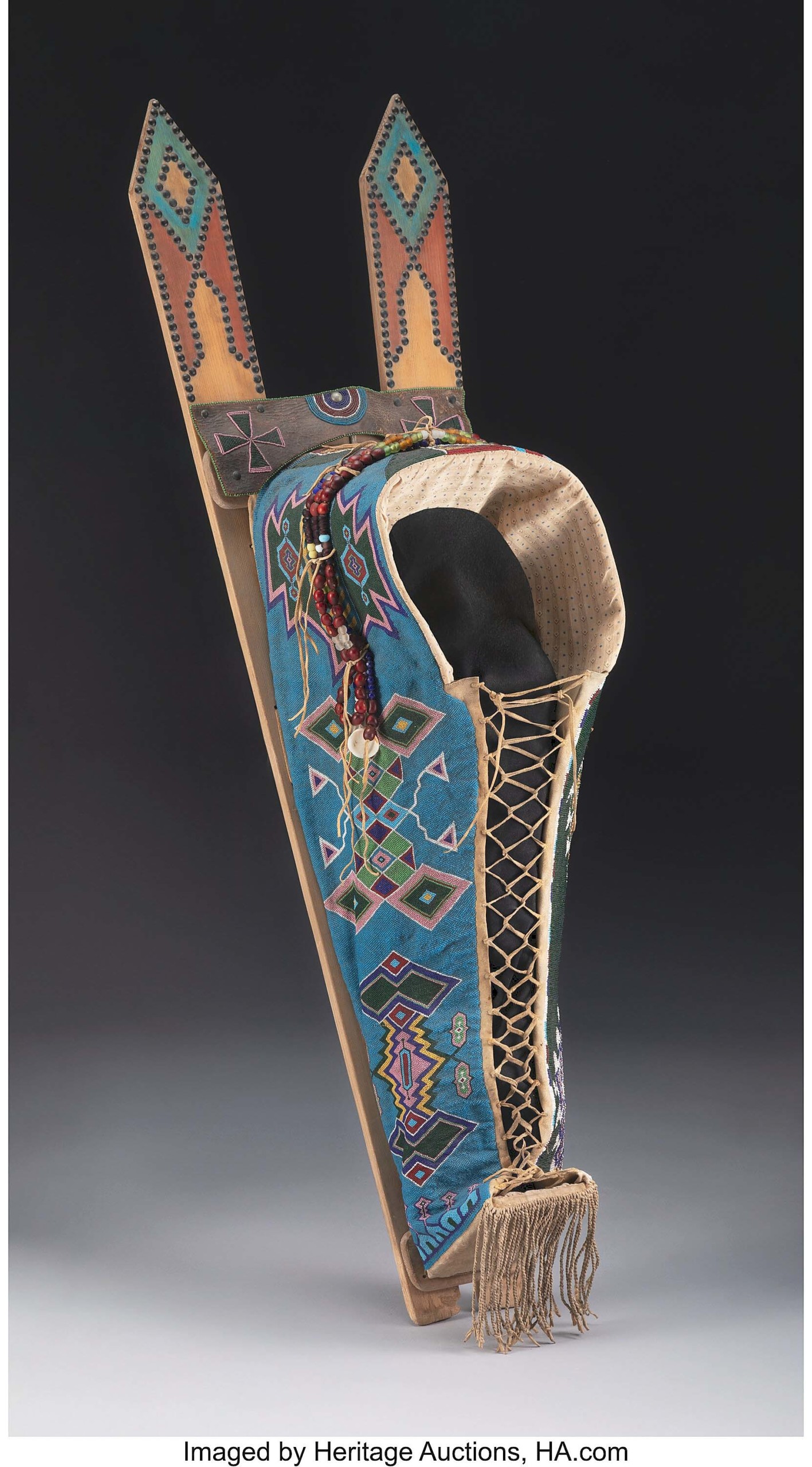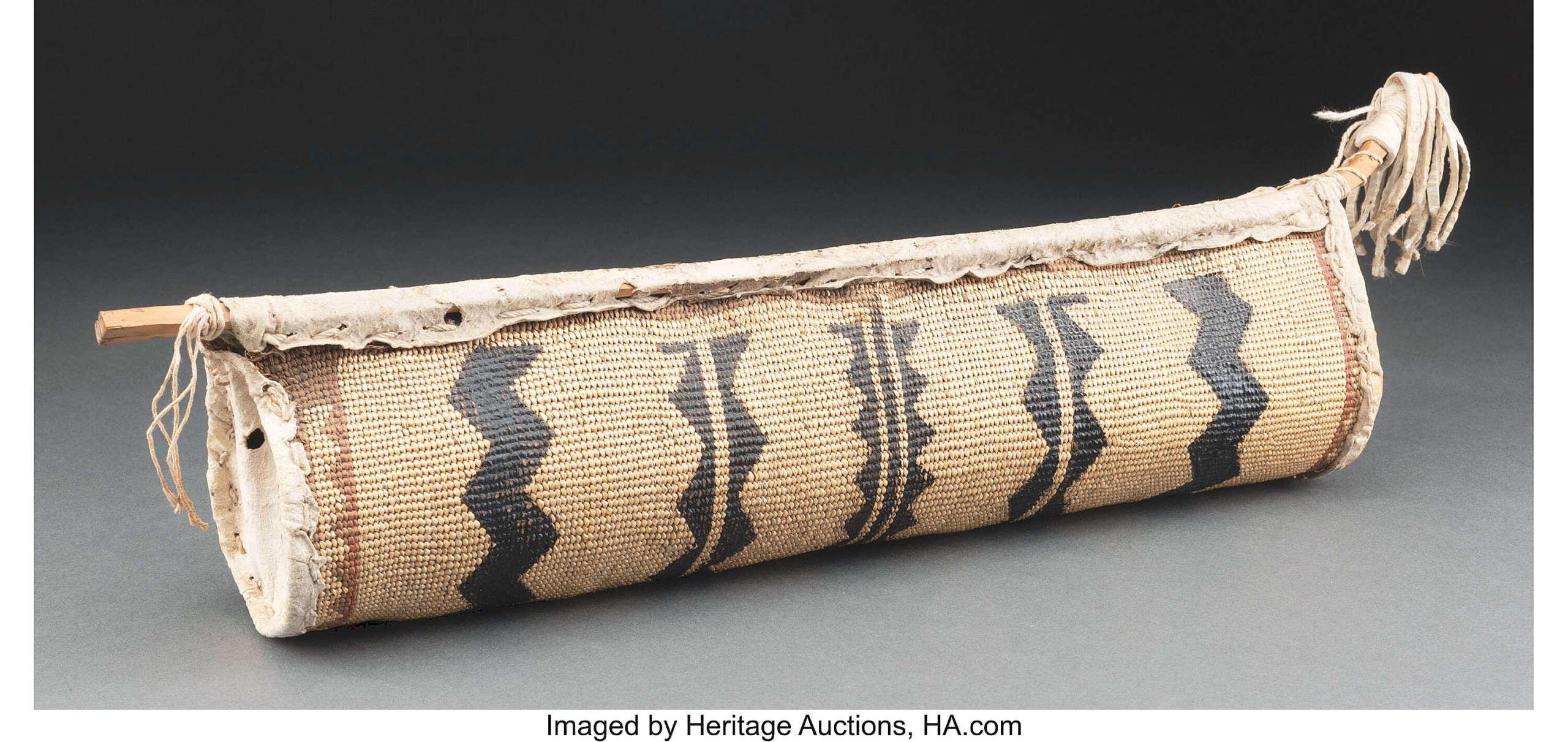
A private collection in Scottsdale, Ariz., supplied the sale with nearly 50 lots, including the sale’s highest priced lot, this Comanche beaded hide baby carrier that dated to circa 1890 and sold for $85,000.
Review by Madelia Hickman Ring
DALLAS — The October 30 Ethnographic Art American Indian, Pre-Columbian and Tribal Art Signature auction at Heritage was conducted in two sessions: a live session of 432 lots followed by an additional online-only 136 lots. At press time, $1,184,972 had been tallied.
Delia Sullivan, director of Ethnographic Art, shared her post-sale thoughts with Antiques and The Arts Weekly. “The Native American material performed very well. We saw very strong prices for some terrific pottery, most notably a Four Mile bowl that sold for $12,500 and a contemporary Cochiti bowl by Diego Romero, which reached $10,312. We had baskets that were in excellent condition; especially noted is a Hupa jump dance basket that sold for $18,750; and very desirable beadwork, including the cover lot, a Kiowa/Comanche baby carrier that went for $85,000. In the Pre-Columbian section, the Mayan ceramics and all the ancient gold items sold very well, better than expected. A superb Cocle deer pendant sold for $18,750. European collectors actively bid in our Tribal art section; a terrific Ekoi janus headdress, appropriately described as extravagant, sold for $9,375. Oceanic art was also in demand, a terrific Maori hei tiki jade pendant sold for $13,750.
Native American objects took some of the highest prices of the sale, including the auction’s cover lot, a striking Comanche beaded hide baby carrier that came to auction from a private Scottsdale, Ariz., collection and earned $85,000. Made circa 1890, the piece was made out of wood, pigments, brass tacks, commercial leather, hide, glass seed beads, cotton cloth, globular glass seed beads, seeds, shells and thread and measured 45 inches in overall length.

The auction included 75 Pre-Columbian lots from Central and South America. This Panamanian Cocle gold deer pendant with bold figuring dated to 600-1000 CE and brought the highest price of $18,750.
Another baby carrier of slightly earlier age — circa 1880 — and from the Crow tribe, was from the same private collection and earned $18,750.
Baskets were a popular form and the sale offered numerous examples, including a very large Apache pictorial coiled storage jar, made from willow and devil’s claw by Hattie Randall around 1928, which rose to $20,000. While it also was part of the Scottsdale private collection, it had also been owned by Thousand Oaks, Calif., collector Robert “Trader Bob” Bayuk. Illustrated in Clara Lee Tanner’s Apache Indian Baskets (Morning Star Traders, 1982), it was noted to be a “fine example of Western Apache weaving” that reputedly took Randall 14 months to weave.
A Washoe polychrome jar attributed to Maggie James, circa 1910, also had provenance to Bayuk and the Scottsdale collection; it topped off at $11,875.
Earning $18,750 was a circa 1910 Hupa twined Jump Dance basket made of bear grass, maidenhair fern, wood, hide and cotton string.

This circa 1910 Hupa twined Jump Dance basket measured 21 inches in length overall and rose to $18,750.
The Bend, Ore., collection of Bill Boyd, was the provenance for a pair of Southern Cheyenne beaded hide boot moccasins that dated to circa 1885. The pair, which had yellow ochre pigment on hide and buffalo hide, were noted to be in excellent overall condition and earned $12,500.
More than 40 lots of pottery artifacts, from a broad span of cultures, were on offer. Native American examples crested at $12,500, with a Four Mile polychrome bowl, circa 1100-1300 CE, that had been published in Karl L. Horn’s Fourmile Polychrome & the Florescence of White Mountain Red Ware (Schenck Southwest, 2024), Billy Schenck’s Women Artists of the Ancient Southwest (Schenck Southwest, 2024) and Casas Grandes and the Ceramic Art of the Ancient Southwest, which was edited by Richard F. Townsend (Art Institute of Chicago, 2005).
Northern North American and Eskimo artifacts were represented by a Northwest Coast copper dagger from circa 1880 that was worked from copper, abalone shell and hide and featured a handle carved in the shape of a face; it closed at $15,000. For $12,500, an Eskimo sea mammal mask, made from wood, paint and sinew, circa 1875, traded hands.
A $23,125 price was achieved by an ancient Indo-Gangetic anthropomorphic figure from Uttar Pradesh, India, circa 1700-1200 BCE, that stood 17 inches tall. The catalog entry drew similarities between this example and three comparable figures in the collection of the Metropolitan Museum in New York City; their purpose was considered mostly dedicatory.

This circa 1700-1200 BCE Indo-Gangetic anthropomorphic figure was shown by Carlton Rochell Asian Art at the Frieze Masters exhibition in London in 2022. The catalog noted its close comparison to examples at the Metropolitan Museum. A determined buyer won it for $23,125.
Two Maliah Khond patinated bronze figures also from India (Orissa) and dating to the Twentieth Century were from the private collection of Dr John Ross, Sr, and achieved $538.
Several Central and South American artifacts also bagged high prices. A Cocle gold deer pendant, made in Panama circa 600-1000 CE, measuring 3 inches long, brought $18,750. Noted to be “an imaginative and unique expression by a master gold artist of ancient Central America,” it was in excellent condition other than a minor casting flaw on the back of one leg. A Veraguas gold eagle pendant, also made in Panama, circa 700-1000 CE, was being sold from the collection of Jonathan Kern to benefit 501(c)(3) charities; it raised $13,750.
Trading hands for $15,000 was a Maya lidded cache bowl, from the early Classic Period (circa 250-450 CE) that boasted provenance to the Stendahl Gallery in Los Angeles and the Paducah, Ky., estate of Albert Whittington (1873-1966). Made of blackware with incised glyph decoration, it was a type that would have been interred with a king or important dignitary, used to hold precious objects needed in the afterlife.

At 4 inches tall, this Maori figural hei tiki pendant that was carved from green jade or nephrite achieved $13,750. It was made in the Nineteenth Century in New Zealand.
A Nineteenth Century hei tiki Maori figural pendant from New Zealand, carved from green jade, measured 4 inches tall and had once belonged to Lance Entwistle (London) and Arman Fernandez (New York City). Considered to be in excellent condition as well, it attracted bids to $13,750.
The next Ethnographic Art auction featuring American Indian, Pre-Columbian and Tribal Art will be June 4. Prices quoted include the buyer’s premium as reported by the auction house. For information, 214-528-3500 or www.ha.com.




















